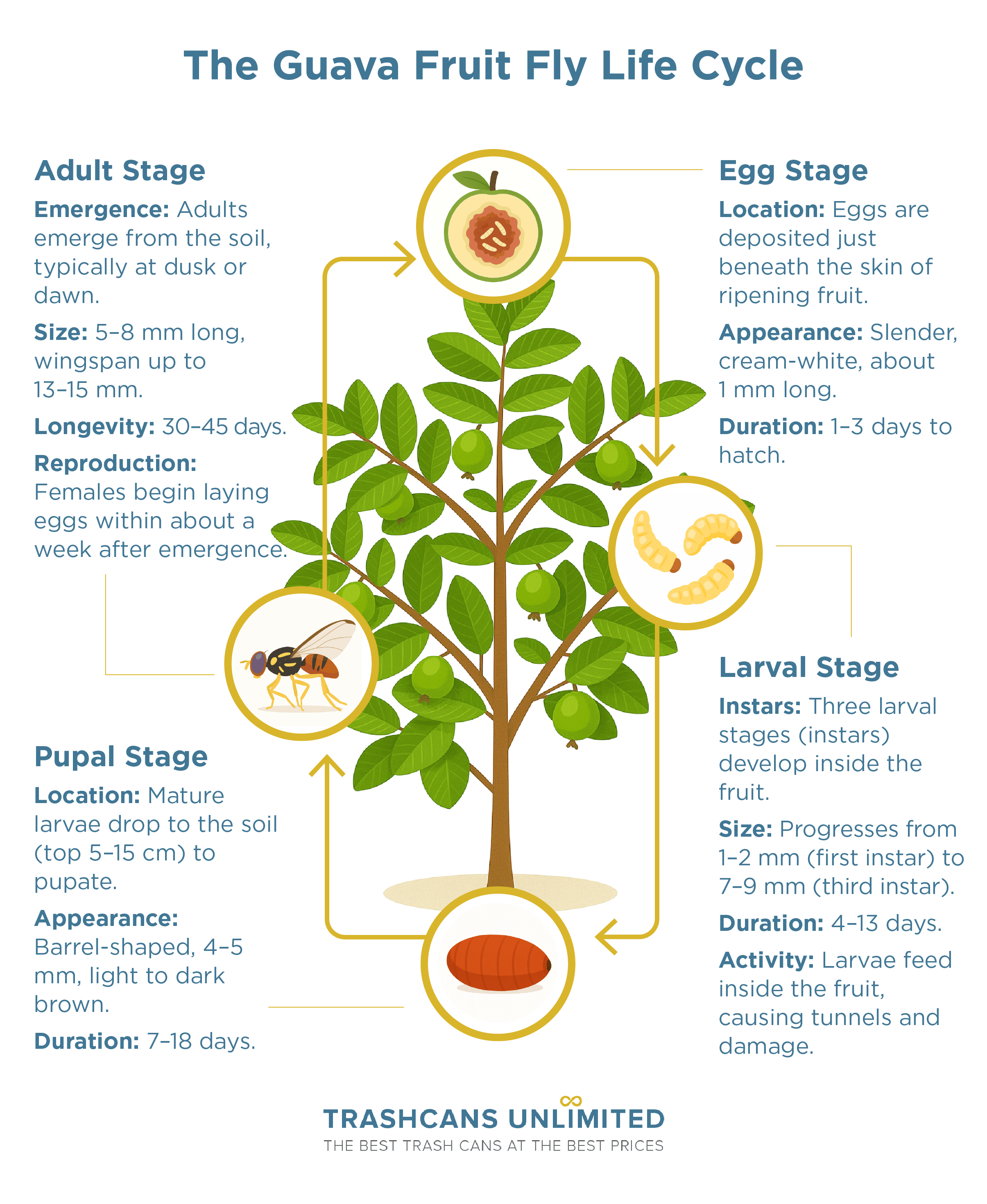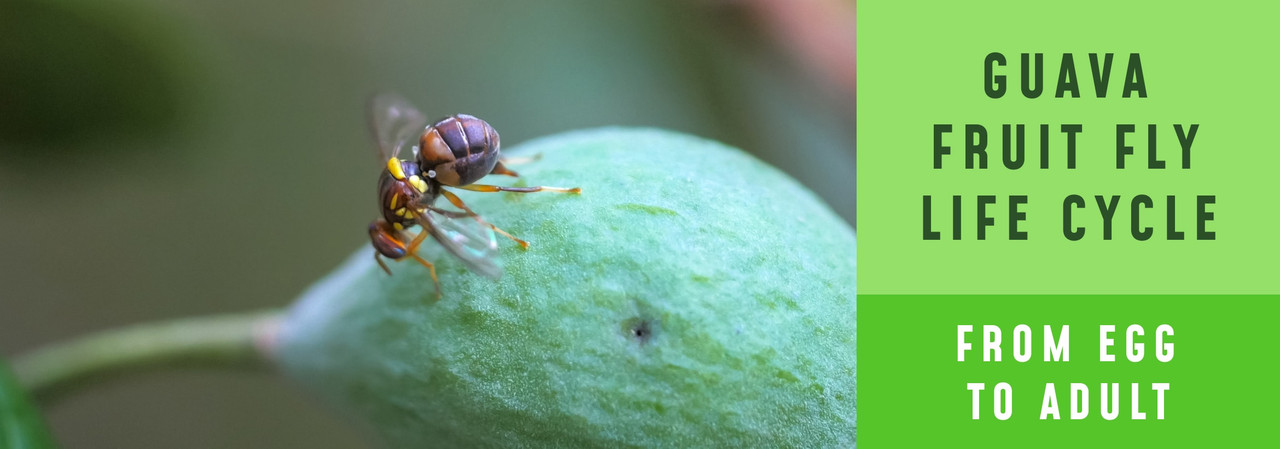You know that a single overlooked guava fruit fly can rip through your harvest before you even notice it—up to a third of your crop gone to unseen larvae under the skin of every fruit. With optimal temperatures, that infestation can start, grow, and spread in as little as three weeks. Understanding the guava fruit fly life cycle in detail is essential for timely action. Recognizing each life stage on sight, timing your monitoring to the season, and using the right containment equipment are the difference between a healthy yield and a total loss.
Key Takeaways
- Identifying guava fruit fly life cycle stages early helps guide effective fruit fly pest control tactics.
- Infestations can cause more than 30% crop loss.
- Recognizing Bactrocera correcta (guava fruit fly) helps avoid oversight during inspections.
Life Cycle of Bactrocera Correcta (Guava Fruit Fly)
You’ll spot the guava fruit fly life cycle through its four-stage metamorphosis—egg, larva, pupa, adult—in roughly 21–48 days, depending on temperature and humidity. Catching them early at each juncture stops population booms in their tracks, preventing fruit fly infestations before they take hold..
Taxonomic Classification: Family Tephritidae, Order Diptera
B. correcta is classified within the fruit fly family Tephritidae under the order Diptera. This group includes many species that affect commercial fruit production and share similar life strategies.
Typical Dipteran features include:
- Full metamorphosis across four life stages.
- A single pair of working wings.
- Flight-balancing halteres.
- A specialized egg-laying ovipositor in females.
Scientific Name: Bactrocera correcta
Initially documented by Bezzi, this species bears the scientific name Bactrocera correcta, distinguishing it from its relatives within the same genus.
Key identifiers include:
- Mostly black thorax with yellow stripes along the sides.
- Black band across the lower part of the face.
- Clear wings with a narrow brownish band along the front edge and a small brown spot near the tip.
- Reddish-brown abdomen with a distinctive black T-shaped pattern on the upper side.
- Yellowish legs, except the back lower leg segments are pale brown.
- Adult size is about 5.4 mm long.
Egg Stage
Picture this: you inspect ripening guava at dawn and spot tiny puncture marks. That’s when females have already laid clutches of 5–10 eggs just beneath the skin.
- Appearance: Slender, cream-white, about 1 mm long.
- Development: 1–3 days to hatch at 77-86 °F (25–30 °C).
- Your Action: Examine fruit every 48 hours during peak ripening; use a 10× magnifier to check for discoloration around punctures.
Larval Stage
Inside each guava, up to three larval instars feed relentlessly, creating tunnels that invite pathogens.
- Duration: 4–13 days total (instar I: 1–2 mm; instar II: 3–5 mm; instar III: 7–9 mm).
- Signs: Soft spots, leaking juice, brown tunnels when you slice fruit open.
- Your Action: Collect 10–15 fruits per hectare across canopy zones; slice laterally—any maggot tunnels mean immediate removal and destruction.
Pupal Stage
After feeding, mature larvae drop into the top 5–15 cm of soil to pupate.
- Pupal form: Barrel-shaped, 4–5 mm, light to dark brown
- Timeline: 7–18 days at 77-82 °F (25–28 °C); soil moisture 40–60%
- Your Action: Sample soil under trees (500 g from 4–6 spots), sift through 2 mm mesh, float in water to recover pupae. Use dedicated soil-sample trays so you don’t cross-contaminate sites.
Understanding this hidden part of the guava fruit fly life cycle helps with preventing fruit fly infestations by identifying where populations may be hiding between crops.
Adult Stage
Emergence happens at dusk or dawn—those are your prime inspection windows. Adults mate on foliage, and females begin egg-laying within a week.
- Size: 5–8 mm long, 13–15 mm wingspan.
- Longevity: 30–45 days.
- Behavior: Strong attraction to fruit volatiles; males to methyl eugenol.
- Your Action: Hang 4–5 male-attractant traps per hectare, 1.5–2 m high in shaded canopy; check weekly, refresh lures every 4–6 weeks.
This adult stage completes the guava fruit fly life cycle and starts it anew. Break the cycle here to succeed at fruit fly pest control.

Economic Significance As A Major Pest Of Guava And Other Fruits
These flies have serious economic consequences. Female guava fruit flies pierce ripe fruit to deposit their eggs, triggering decay and allowing pathogens to invade.
Notable effects include:
- 20–30% production loss in infested farms.
- Drop in fruit grade and market price.
- Possible export limitations from quarantine enforcement.
This makes it essential to understand the guava fruit fly life cycle to mitigate risk and reduce costly losses.
Geographic Distribution And Spread Patterns
The species is native to and widely found in:
- India
- Thailand
- Malaysia
- Indonesia
- Southern parts of China
Its presence intensifies when fruiting is at its peak, and movement across regions can occur via the transport of infested produce.
In the United States and elsewhere, only isolated instances of interception have occurred. The species has been intercepted in Florida and California, but these records represent single finds or short-term outbreaks, not self-sustaining populations. For example, Florida trapped a single male in 2011, and California caught several in Long Beach in 2015, but in each case, the fly was eliminated.
Distinction From Other Fruit Fly Species
Comparing key timings helps you choose fruit fly pest control tactics strategically:
| Species | Egg–Adult Duration | Optimal Temp. | Implications for You |
| B. correcta | 21–48 days | 77-86 °F (25–30 °C) |
Plan bi-weekly trap servicing inwarm spells. |
| B. dorsalis | 16-23 days | 72-82 °F (22–28 °C) |
Capable of a longer life cycle under the right environmental conditions. |
| Ceratitis capitata | 25–30 days | 68-77 °F (20–25 °C) |
Similar pace but favors cooler climates. |
Because B. correcta races through its cycle in as little as three weeks, preventing fruit fly infestations requires higher trap densities and faster removal of infested material than for longer-lived species.
Complete Life Cycle Duration
The guava fruit fly completes its cycle in roughly 21–48 days, depending on external conditions, especially heat, and access to preferred fruit.
Seasonal Variations and Temperature Effects
- Warm months 77-86 °F (25–30 °C): complete cycle in ~21 days; populations explode—service traps every 7 days.
- Cooler months <59 °F (<15 °C): cycle slows to ~48 days; focus on sanitation to break cycles.
Humidity also matters: eggs at 60–80 %, larvae in 70–85 % fruit moisture, pupae in 50–70 % soil moisture, and adults are most active at 65–85 %.
Number Of Generations Possible Per Year In Different Climates
- Tropical regions: 8–10 overlapping generations—year-round vigilance.
- Subtropical zones: 4–6 distinct generations—time control measures to fruiting peaks.
Environmental Influences On Life Cycle
The development and population trends of guava fruit flies are deeply affected by temperature, moisture, and seasonal shifts.
Humidity Requirements At Different Life Stages
- Eggs thrive in 60–80% humidity. Less than that, and hatching success can fall by 40%.
- Larvae need fruit with 70–85% water content. Drier fruits stunt growth and raise death rates.
- Pupae survive best in soil that holds 50–70% humidity. Excess water can drown pupae, while too little dries them out.
- Adults operate best in 65–85% humidity. They mate less often when it dips under 50%.
Seasonal Effects On Population Dynamics
- Fly numbers rise in warm, wet periods—especially when fruit is ripening. Rain events often trigger peak infestations.
- Populations drop in dry seasons due to fewer fruits and drier air. Adults usually take shelter until favorable conditions return.
- Life cycles often sync with guava and tropical fruiting times, producing several overlapping generations.
Climate Change Implications For Life Cycle And Range Expansion
- Warming trends have expanded the active season in regions once too cool for flies to breed year-round.
- Rainfall shifts affect how many pupae survive and when adults emerge. Unusual weather can disrupt reproduction cycles.
- Climate-driven changes in flowering and fruiting also shape breeding behavior and generation timing.
Host Fruit Availability Effects On Population Cycles
- Guava season signals a boom in fly populations. Females are drawn to ripening fruit from afar.
- Other host fruits help maintain fly numbers between guava seasons, allowing continuous life cycles.
- Fruit ripeness matters. Flies seek out fruits at just the right stage for egg laying and larval growth.
- When preferred fruits run low, flies shift to alternate hosts—often raising crop losses in nearby orchards.
U.S. Status and Guava Fruit Fly Pest Control
Bactrocera correcta is a federally regulated quarantine pest in the U.S. By international (IPPC) standards, it is now considered “absent: eradicated” in the United States. The 2015 detection in Los Angeles County led APHIS to impose a quarantine area in May 2015.
Federal and state teams then deployed a male annihilation technique: thousands of methyl-eugenol bait stations laced with spinosad were hung over roads and foliage in the area, and suspected fruit was removed or treated. After no additional flies were caught, APHIS lifted the quarantine in October 2015.
Throughout these actions, agencies cooperated closely. The California Department of Food & Agriculture (CDFA) and USDA ensured high-density trapping, fruit-stripping, and bait sprays around finds. Under this coordinated response, no B. correcta populations ever became established. As a result, no active infestations are known in the U.S. today.
Vigilant monitoring continues. USDA/APHIS and state programs maintain detection surveys in fruit-growing areas. Any suspect catch still triggers immediate quarantine and eradication protocol.
Growers and inspectors are advised to inspect fruit routinely for the small puncture marks of egg-laying and to report any B. correcta-like adults or larval infestations (e.g., maggots in fruit) to agricultural authorities.
Creative Sanitation Solutions
Imagine sealed, wheeled bins with replaceable liners dedicated to fruit and soil samples—no more hand-carried buckets that spill. You streamline cleanup, cut fly carry-over, and keep your team safe from handling larvae.
Equip your operation with resilient outdoor composter bins and lock-tight soil-sampling trays from Trashcans Unlimited—so every fallen guava, every pupal excavation, and every trap check keeps pests contained and your harvest protected.

